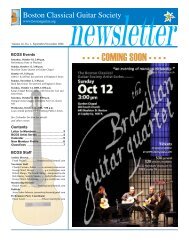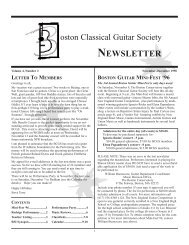2003 Jun-Aug - Boston Classical Guitar Society
2003 Jun-Aug - Boston Classical Guitar Society
2003 Jun-Aug - Boston Classical Guitar Society
You also want an ePaper? Increase the reach of your titles
YUMPU automatically turns print PDFs into web optimized ePapers that Google loves.
<strong>Jun</strong>e/<strong>Aug</strong>ust <strong>2003</strong><br />
BCGS Newsletter Volume 10, Number 4<br />
Music Review<br />
Chasing the Chaconne<br />
By Robert A. Margo<br />
At some point in their musical lives, most aspiring professional<br />
guitarists, and quite a few amateurs, study the Bach<br />
“Chaconne.” The Chaconne is one of the unquestioned masterpieces<br />
of European classical music, and it has long been a<br />
cornerstone of the guitar repertoire. Well played, its effect on<br />
an audience is both dramatic and deeply profound.<br />
The difficulties in performing the Chaconne on guitar are<br />
several. First, the piece is quite long by guitar standards, with<br />
many changes of mood. Stamina, therefore, is an issue, and<br />
this is not usually the case on the guitar. Second, the piece<br />
requires an extremely secure technique, especially with scales<br />
and arpeggios. Third, its musical architecture is supremely<br />
complex. Expressing this structure to the fullest requires very<br />
high levels of musical artistry.<br />
As a guitar piece, the Chaconne was long associated with<br />
Segovia, who triumphantly premiered his version in the early<br />
1930’s. Published by Schott at about the same time, the<br />
Segovia transcription is probably where most guitarists begin<br />
their journey with the Chaconne. Extensively fingered, Segovia<br />
kept the original key, D minor, but added bass (and other) notes<br />
freely to suit his tastes, drawing heavily (it is believed) on the<br />
version for piano by Busoni.<br />
Most subsequent guitar transcriptions of the Chaconne have<br />
followed Segovia’ choice of key signature. One such version,<br />
by the Japanese guitarist Yamashita, eliminates some of the<br />
notes added by Segovia but is otherwise similar. The transcription<br />
by Carlevaro is fingered in accordance with this maestro’<br />
teachings, but is also similar to Segovia’s.<br />
Another transcription in D-minor worth considering is by<br />
<strong>Boston</strong>-area guitarist Jeffrey Steele. Steele’s transcription may<br />
be downloaded from his website for a nominal fee (www.jeffrysteele.com).<br />
Steele adds fewer notes than Segovia and, in<br />
many other ways, sticks closer to the original violin score. The<br />
fingering is also quite logical and the whole sounds uncluttered<br />
and fresh. I highly recommend this version.<br />
To my knowledge, there are two transcriptions of the Chaconne<br />
in E-minor. One of these, by Antonio Sinopoli, predates<br />
Segovia’s transcription by a decade and a half. The Sinopoli<br />
has long been out of print. Another transcription in E-minor is<br />
by the Israeli guitarist Moshe Levy. This version was published<br />
in the March 2001 issue of <strong>Classical</strong> <strong>Guitar</strong> Magazine. As<br />
Levy points out in his accompanying article, E-minor has some<br />
technical advantages over D-minor. First, E-minor facilitates<br />
proper voice-leading in bar 2 unlike in D-minor. Second, in E-<br />
minor it is possible to use the open B-string as a drone in bars<br />
228-239. Although I prefer the sound of D-minor, the Levy<br />
transcription is excellent and worth a careful look.<br />
Another way to go is to make your own transcription. One can,<br />
in fact, play the violin score more or less as written on guitar, if<br />
one is willing to tolerate some extreme stretches in the left<br />
hand and some (very) awkward left hand shifting. But the guitar<br />
is not the violin. Bach’s own transcriptions show that he<br />
freely adapted a piece to suit the instrument. Perhaps the best<br />
approach is to start with the violin score and consider carefully<br />
the choices made by other guitarists, as well as Bach’s own<br />
transcription process. Whichever version one learns, the<br />
rewards will be great.<br />
There have been innumerable recordings of the Chaconne, far<br />
too many to list here. My favorites on guitar include those of<br />
Segovia, Williams, and (especially) Barrueco. I also recommend<br />
listening to one of the many excellent recordings on violin,<br />
such as Nathan Millstein’s (modern violin) or Rachel<br />
Podger’s (baroque violin).<br />
• Strings • Accessories • Videos • Books • Used <strong>Guitar</strong> Classifieds •<br />
“Committed to the <strong>Classical</strong> <strong>Guitar</strong>ist”<br />
★ SERVICE ★ VALUE ★ CONVENIENCE ★<br />
Questions about strings?<br />
Visit one of the most comprehensive websites<br />
available for the classical guitarist.<br />
www.stringsbymail.com<br />
Call, fax, or write for the latest price list.<br />
(Visa & MasterCard Accepted)<br />
Tel: (607) 786-9604 Fax: (607) 786-9372<br />
3650 Lott Street, Endwell, NY 13760<br />
14
















